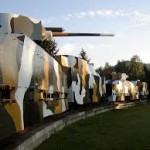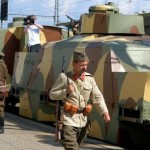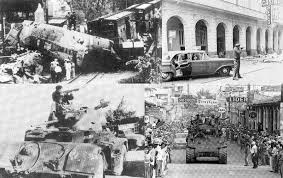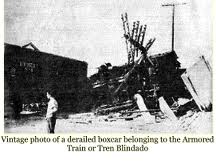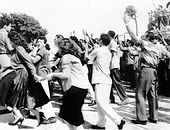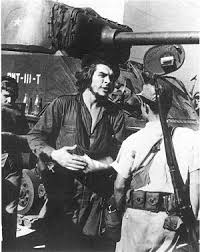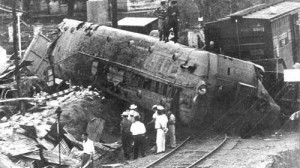FULGENCIO BATISTA’S SANTA CLARA ARMORED TRAIN STORY.
INTRODUCTION:
My name is Henry Louis Gomez and this site is my attempt to wade through the propaganda and dimming memories to uncover the truth behind one of the last events of Cuba’s Batista regime. I became interested in the professional revolutionary, Ernesto ‘Che’ Guevara, after reading a novel by one of my favorite authors, W.E.B. Griffin. During a discussion with my father about the Cuban Revolution in general and Guevara in particular, my father regaled me with what I then thought was an almost unbelievable tale about my grandfather and how he had actually been confronted by the most infamous man to wear a beret.
This is a fascinating story about treachery, possible bribery, and an unlikely prize: an armored train. This episode has become a footnote in Cuban history because it occurred on the eve of Fulgencio Batista’s from Cuba, and was therefore overshadowed by it. The truth about these events is important however because it sheds light on the character of the men who lived through them as well as the illegitimate nature of the Cuban Revolution itself.
THE “BATTLE” FOR SANTA CLARA AND THE ARMORED TRAIN.
By the fall of 1958 Batista’s offensives against the various Rebel forces had largely failed. In November, under pressure from the U.S., Batista held elections in which Andres Rivero Aguero, his handpicked successor, was declared the winner. This election was popularly regarded as a sham. In any case Rivero was set to assume power in February of 1959. Castro did not want that transition to take place. Sensing that there would be a small window in which the Rebels could win the war and he could establish a new regime without U.S. interference.
Anti-Batista sentiment was becoming much more prevalent among everyday Cubans. The army was demoralized, not wanting to die for a regime which, it was obvious, wasn’t going to survive much longer. The town of Santa Clara is located in Las Villas province in roughly the center of the island. Emboldened by the lack of resistance the guerillas were facing from the Cuban armed forces, Castro decided to send forces to Las Villas province to capture the city and cut the island in half.
He charged Guevara with the responsibility of leading this force known as “Column 8”. Castro was fond of these grandiose names. He had several “columns” under his command on several “fronts”. Each of these “columns” had maybe 150 men. They were largely untrained and lack of discipline among the men was a common problem. Guevara established a reputation for maintaining the discipline of men entrusted to his command. He did it at the end of a gun. It’s been well reported that he personally executed more than a few of his men for “treason”. In any case the capture of Santa Clara posed a significant challenge as it was roughly 250 miles from the Sierra Maestra and was home to a rather large garrison fort. Guevara and his men made the trip in 5 weeks, largely avoiding contact with Batista’s forces, arriving in Las Villas province in early December 1958. By that time it was apparent to American observers in the U.S. Embassy that the Batista regime was going to fall, it was just a matter of when. There was a lot of confusion about the actual progress Rebel forces were making because of government censorship and conflicting propaganda coming from both sides.
One of the biggest problems facing Batista was the sabotage of the country’s roads and bridges in the areas the Rebels were controlling. To alleviate the problem, he dispatched an armored train full of men and materiel. Guevara’s and the official Castroite version of the story contend that this was a major offensive aimed at crushing the Rebellion once and for all. But the truth is that the 340 officers and enlisted men on that train belonged to the corps of engineers. Among them was my grandfather, by that point a captain. Batista did not lack infantry troops, his forces greatly outnumbered Rebel forces in almost every engagement of the war. In fact the garrison fort in Santa Clara contained several thousand well-equipped men. The town also contained several hundred police officers that had been summoned from around the province. What he lacked at that point was troops that were committed to fighting for and possibly dying for him. The objective of the men on that train was to repair bridges and roads that had become casualties of the war thus far. The highest-ranking officer aboard the train was Colonel Florentino E. Rosell y Leyva. In addition to being my grandfather’s commanding officer, Gomez Perez knew Rosell personally and socially.
The train departed Havana on or about the 23rd of December. After some setbacks it reached the town of Santa Clara on or about 25th of December. The train came to a stop at the foot of the Capiro Hills. Soldiers were placed on the hill to defend the train but on the 29th of December they pulled back from their defensive positions when faced with Rebel fire. It became apparent that the train was in a bad location since the Rebels were now holding positions in the higher terrain of the hills and were firing down on the train. Though the train was armored on its sides the roofs of the various carriages were unprotected. The train was ordered to move away from the hills and closer to the town. Anticipating this move some of the guerillas used a bulldozer to destroy a section of the railroad track. This caused the several of the carriages to derail. The officers and men eventually surrendered the train to Che Guevara. With the exception of the nature and purpose of the troops aboard the train, all accounts generally agree on the details to this point.
The purpose of this site is to explore the circumstances surrounding the surrender of the train. One might ask why this is important. In the end, a surrender is a surrender. But since those fateful day since late December 1958 it has been rumored that Colonel Rosell “sold” the armored train; that he was given cash to surrender the train and its contents to Che Guevara. If true, these allegations shed a new light on Guevara’s “genius” as a guerrilla strategist. After all this was his biggest victory as a professional revolutionary. His subsequent failures in the Congo and Bolivia (where he was caught and killed) are well documented so if he indeed took Santa Clara without the heavy fighting he reported in his diaries and that has been accepted as the official version of the events, then his entire career as a guerilla commander would be largely a fraud.
Colonel Rosell presumably arrived in Santa Clara by airplane on the 24th. He participated in a somber noche buena, (Christmas Eve dinner) with the officers in the garrison fort. He ate breakfast aboard the armored train on Christmas morning, yet he was not among the surrendering officers and enlisted men a couple of days later. Rosell’s brother, a local politician in Santa Clara was seen by my grandfather when he came to visit the colonel aboard the train. Gomez later saw both brothers depart with several briefcases in automobiles. Colonel Rosell never returned to the train leaving it in the command of Comandante Gomez Calderon (no relation to my grandfather Gomez Perez). That Colonel Rosell abandoned the train is not in doubt. His motivations are. Was he returning to Havana under orders of his superiors? Was he going to update Batista on the situation in the field? Was he a coward who did not want to be caught by Rebel forces and executed? Or was he bribed to surrender the train and then (in an act of self-preservation and greed) abandoned it and the men in his command?
THE COLONEL’S GONE FISHING:
My grandmother was naturally worried about my grandfather. She had not heard any news of the train, its progress or its location. She decided to pay Colonel Rosell’s family a visit in their home just outside of Havana. My father Enrique L. Gomez who was 16 years old at the time drove his mother there since she did not at that point know how to drive a car. When they arrived they found the house was completely dark. They knocked on the door and after some time the Colonel’s mother in law opened the door. She seemed out of sorts. My grandmother asked what had happened to the armored train and what had happened to the Colonel.
The woman responded that she didn’t know what happened to the train but that Rosell had arrived that morning and gone fishing on his yacht. “Fishing?” my grandmother asked incredulously. The woman said yes, that he had left on his yacht saying he was going fishing. She added that the SIM (Military Intelligence Service) had been by the house and ransacked it. She said the SIM men had left only 20 minutes before my father and grandmother arrived and showed them how they had turned the house over. My father and grandmother decided to leave Rosell’s home for fear of getting caught up in whatever was going on.
Colonel Rosell flew from the air base in Santa Clara to Havana and departed on his yacht for Miami. He had sent his wife and children ahead of him several days before. Rosell immediately became quite wealthy in Miami with a construction company. Those who subscribe to the theory that he did indeed accept a cash payment for the surrender of the train point to this as proof that he came to U.S. with a substantial amount of “seed capital” but by all accounts Rosell was wealthy in Cuba. In those early days, immediately before and after Batista fled, some Cubans were able to escape with some of their assets so it’s not inconceivable to think that he moved his savings to Miami at some point during those fateful days.
FACING CHE
The derailed train was fired upon and returned fire sporadically for some time. At one point voices outside the train began yelling “The International Red Cross is asking for a ceasefire, the International Red Cross is asking for a ceasefire.” My grandfather who was in one of the carriages closest to where the voices were coming from came out to address the men who were asking for the ceasefire. He was accompanied by another officer who was also a doctor by the name of Valdez Infante. The men who had come to ask for the ceasefire said that the Comandante ‘Che’ Guevara wanted to speak with the train’s commanding officer. My grandfather asked one of the men on the train to send for Gomez Calderon. Meanwhile the men escorted my grandfather and Valdez Infante into a house. From that house he passed to another house through a hole that had been made in the wall as a sort of passageway. After passing through several houses in this manner he was finally face to face with Che Guevara.
My grandfather’s identification of Guevara was positive. He was wearing an arm cast and a sling on his broken arm. Guevara had broken it earlier in the campaign. Guevara asked why the Rebels had been fired upon by the men on the train. “This is not what we had agreed to!” My grandfather explained that he knew nothing of any agreement. At that point Gomez Calderon arrived and Guevara repeated his question. Gomez Calderon also said he knew nothing of an arrangement. Guevara seemed legitimately upset. He explained to the three army officers that the battle to save the Batista regime was lost and that the train was vulnerable. That the men aboard could fight and be killed or they could surrender the train and join the Rebels or otherwise return to Havana. Gomez Calderon said that he preferred not to make a decision on the spot. That he wanted to confer with the other officers aboard the train. The three officers returned to the train. My grandfather never saw Guevara again. Ultimately the officers agreed to surrender. All of the men were given the option to join the Rebel forces. Only one man took the Rebels up on the offer. The officers were then separated from the men and the officers were then transported to the port of Caibarien, which was under Rebel control. They spent the night of the 30th there and departed for Havana on a navy vessel the following morning. My grandmother received a call from a friend of my grandfather’s named Jesus Blanco whose brother was in the navy. Blanco stated that my grandfather would be arriving that night at about 11:00 PM on a vessel captained by his brother. My father and grandmother arrived at the docks at 10:30 and at 11:00 the vessel arrived as scheduled. My grandfather was only able to speak to his son and wife for a couple of minutes as he was being taken from the vessel to a bus. He explained that “it’s all over, the Rebels completely control Santa Clara.”
It seems incongruous that the Rebels would capture the train and simply allow the officers a safe return to Havana. It’s worth mentioning that the Rebels really had no interest in keeping these men prisoner. Prisoners needed to be guarded and fed. The Rebels being the small force that they were of course couldn’t spare the men or supplies to do this. Besides they were promising amnesty to all officers and soldiers who surrendered without a fight. Castro had broadcast certain edicts that resistors to the revolution would be tried as traitors and if found guilty be sentenced to an execution by firing squad. How much this weighed on the minds of the soldiers that were being asked to fight the Rebels cannot be underestimated. Sending the officers back to Havana posed little risk to the Rebels. They knew that the men would be viewed as traitors by the army and would not be trusted again with commands. In the end it became irrelevant because shortly after the vessel with the officers from the armored train arrived on the evening of the 31st, Batista fled Havana and the Rebels had their victory.
UNCERTAINTY:
Once in Havana my grandfather was kept at an air force base for several weeks before being released. Remember that once Batista fled, Fidel Castro’s chosen President, Manuel Urrutia Lleo, was recognized by the United States and by the Cuban people as the legitimate leader of Cuba. The soldiers, seamen and airmen of the Cuban armed forces now officially worked for the Revolutionary government. Castro initially guaranteed the jobs of all military men that were not deemed as treasonous to the revolution. He calculated correctly that if he could keep the military happy until he could consolidate his power that he would then be in a better position to remake the Cuban armed forces with men loyal to him. My grandfather continued on as a doctor in the army for several months until he was discharged of his duties.
CONCLUSIONS:
In various books about Che Guevara the capture of the train is portrayed as the critical moment in the battle for Santa Clara. The entire image of Che as a master guerilla strategist is built upon it.
In his book, Respuesta, Fulgencio Batista says that General Francisco Tabernilla Sr. and General Pedro A. Rodriguez Avila “informed me that Colonel Florentino Rosell, without authorization from his superiors, had to return to Havana, saying that he needed to render urgent information. The following day they informed me that Colonel Rosell had deserted. During the morning, he left by sea, the assumption being that he was headed to some port in Florida in the United States of America.”
In an article that appeared in El Diario de Nueva York on June 25th 1959, Francisco Rodriguez Tamayo, AKA “El Mexicano”, who was a captain in the Rebel Army and Humberto Olivera Perez who was a captain in Cuba’s Regular Army, state that “…many of the “battles” that were won by rebel forces were in reality “purchases” made by the rebel army off of Batista officers.” The article continues, “According to them, Colonel Ernesto [sic] Rosell for a sum (that some sources say was $350,000 and others say was $1,000,000) sold the armored train in Santa Clara to “Che” Guevara. He sold not only the whole train, but also the arms and troops aboard it.”
In the same article “El Mexicano” talks about how the Rebels collected funds for the purposes of bribing Batista forces and purchasing their weapons and he claims that “When all the battles were done, Fidel had, in the 26th of July headquarters, some $4,500,000 left for those purposes. I don’t know what might have happened to that money.”
My grandfather’s account of Guevara’s reaction to the shots fired from the train is consistent with a man who felt he had been swindled. My grandfather also stated that the officers on the train were all speculating that Rosell had been paid. This gives us some insight as to the feelings of the rank and file soldiers who apparently were aware of the allegations that battle victories were being routinely bought by the Rebels.
Jorge Castañeda, in his biography of Guevara, writes that Eloy Gutierrez Menoyo, a rival Rebel leader claims he had negotiated a surrender with Rosell but that Rosell’s brother spoke to Che Guevara and instead of surrendering the train to Gutierrez Menoyo the train would be surrendered to Guevara. This detail is important because of the weapons that were believed to be aboard the train. With those weapons Guevara and the 26th of July forces would be much better armed than the rest of the Rebel groups. Castañeda quotes Gutierrez Menoyo as saying “I discussed this two or three times with Guevara and asked him ‘what did you offer that I didn’t?’ He only laughed and never confessed the truth to me.”
For his part, Che Guevara writes in his memoirs of the Cuban Revolution that an incredible battle took place. That the Rebels threw Molotov cocktails on the train’s carriages making them into ovens and that after fierce fighting the train was surrendered. This is almost certainly not the case. My grandfather never mentioned a single soldier on that train as having been killed or seriously injured. This, like so much else that is written about the Cuban Revolution, is simply a myth. A large segment of populace of Santa Clara were in support of the Rebels. The men on the derailed armored train were cut off from their fellow soldiers in the garrison fort. They had been abandoned by their commanding officer. They weren’t even infantrymen. They were prepared to build bridges and repair roads not kill fellow Cubans while trying to suppress a popular revolution.
Rosell lived in Miami until his death in January of 2007. He wrote a book in 1960 entitled, La Verdad (The Truth) explaining his side of the story. In their 1980 book, The Winds of December, John Dorschner and Roberto Fabricio state that in the interview they conducted with him, Rosell admits to having lied about certain details in La Verdad. The irony of that statement should not be lost on the reader.
Dorschner and Fabricio do not mention the rumored sale of the train. In their version of the events, Rosell flees because he fears being arrested by SIM as a traitor because he had hatched a plan with other army officers to oust Batista and come to an agreement with the Rebels to install a new ruling junta. Supposedly once Guevara and the Rebels rejected the plan, and its very existence was made known to SIM and Batista, Rosell had nowhere to go but Miami. Various sources agree that Rosell was among several officers that were displaying defeatist attitudes during those December days, looking for accommodations with the Rebels. Rosell definitely appears to have been spinning, what Dorschner and Fabricio call a “web of intrigue.”
WEB OF INTRIGUE.
This web of intrigue is underscored by an account given to me by Santiago de Juan. Mr. de Juan owned 2 radio stations in Cuba and managed 5 others. He was also a member of the Havana underground working for the Directorio Revolucionario 13 de Marzo with the code name of Marcos Duran until his situation in the city became untenable. He then went to the Escambray mountains where he participated in joint actions with the 26th of July forces. On the morning of December 24th, while attempting to travel from Placetas to Santa Clara in an automobile and disguised in civilian , he was stopped at a checkpoint. A colonel directed him out of earshot of his traveling companions. There the colonel made it clear that he knew who de Juan was and what he was up to by saying “Listen, I am an Engineer and you are a Radio Station owner, so lets talk like such, okay?” After a brief exchange of words about what had happened in Placetas, the colonel asked de Juan to meet him in the restaurant of the Gran Hotel in Santa Clara.
Santiago de Juan explains what happened next “We were having lunch at the hotel restaurant just a few minutes past noon, when the elevator door opened and out came Rosell Leyva, by himself. As a courtesy, I got up and walked toward him and we met halfway, by ourselves. He greeted me with a ‘buenas tardes’ and again, without beating around the bush asked: ‘Have you heard of the Tren Blindado?’ The truth is that if I did, I could not really remember but so as not to sound stupid, I said yes with a gesture of my head. Then he continued and said: ‘In the next few days, the train will not have much protection.’ he extended his hand which I accepted and bid me ‘buenas tardes’ again, turned around and that is all I know about him.”
Mr. de Juan corroborates Dorschner and Fabricio’s version inasmuch as Rosell was trying to send a signal to the Rebels that he would turn the train over without a fight, quite possibly as a gesture of goodwill to them, believing the war was lost. One thing is certain, he was not acting like someone who was committed to carrying out the mission he had been entrusted with. I think it’s a little far fetched to believe that Rosell acted instinctively when he fled and that he did not premeditate his departure to Miami, given that he sent his family ahead of him.
The Rebel forces were well financed by wealthy Cubans that wanted to oust Batista. Castro also extorted money from the businesses (mostly sugar mills) in the areas he controlled. Dorschner and Fabricio detail one instance where a Sugar Mill president paid a $450,000 “tax” to the Rebels. Paul Bethel documents in his book, The Losers, an instance in which a large sum of money was paid by Che Guevara to army officials for safe passage through otherwise hostile territory. Bethel’s opinion of the armored train episode is that Rosell “sold the train to Castro. A few shots and bombs to make it look good, and the deal was consummated in a triumph of Castro propaganda.”
It is possible that Rosell was in fact paid a large sum of money to surrender the train. But wanting to hedge his bet in case of a double cross, he took the money and fled to Miami. Where I differ with Bethel is that I believe that any shots that were fired by Cuban soldiers during the brief engagement were legitimate since Rosell was gone and the men knew nothing of an “arrangement.” Although Rosell reneged on his deal ultimately Che got his prize, his legend and later his comeuppance in Bolivia.
FINAL THOUGHTS:
After Castro took power, Che Guevara was placed in charge of the military fort known as La Cabaña. While there he supervised and personally participated in the torture and execution by firing squad of hundreds of Cubans. El Che, to me, seems like the kind of guy who only felt alive when he had the power to kill a defenseless fellow human being in his hands. I doubt that he was ever really a medical doctor. I have yet to see one shred of proof that he ever graduated from medical school and have studied him intensely. In addition to the firing squads Guevara was responsible for setting up the gulag system in Cuba where people were imprisoned for such crimes as being homosexual and listening to rock and roll music. Just the kind of hero you’d want adorning the front of your t-shirt.
SantaClara’s Armored Train/HenryGomez/InternetPhotos/TheCubanHistory.com
Fulgencio Batista’s Santa Clara Armored Train Story.
The Cuban History, Hollywood.
Arnoldo Varona, Editor



